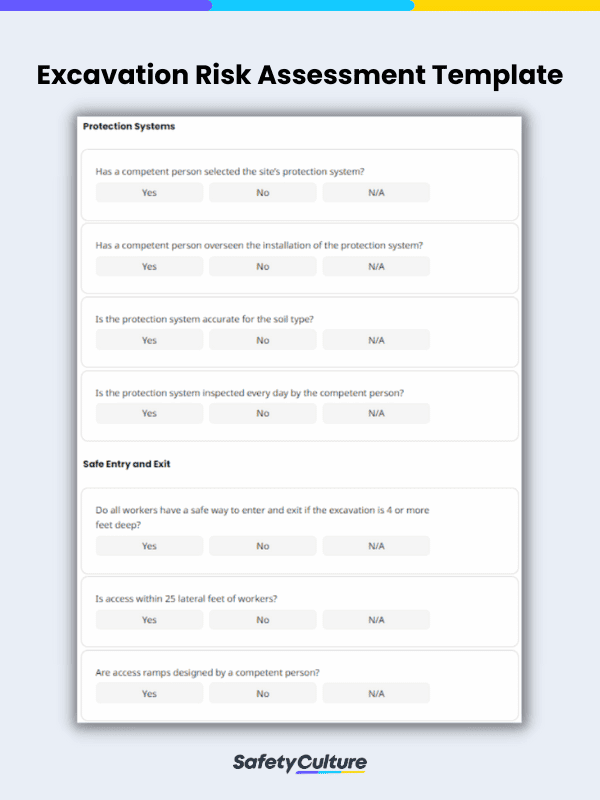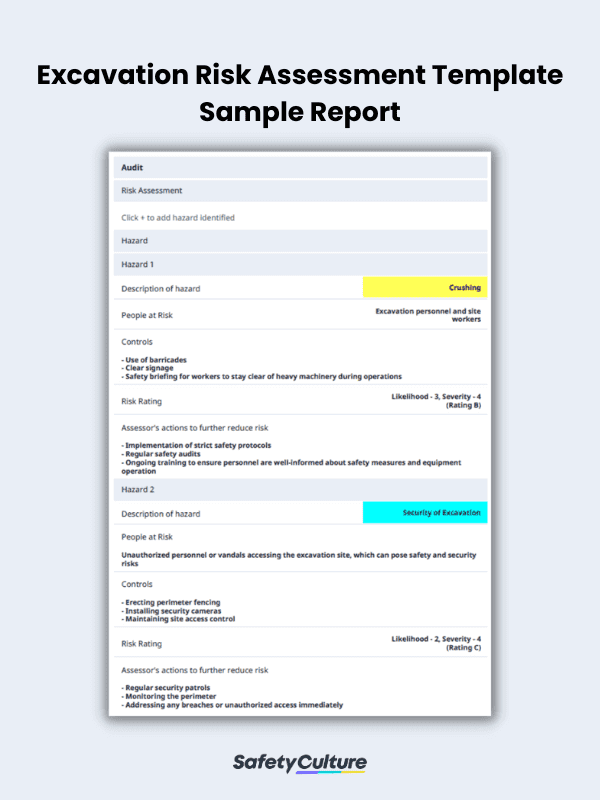What is an Excavation Risk Assessment Template?
An excavation risk assessment template is a standardized document or form used by organizations, construction companies, or project managers to evaluate and manage the potential risks associated with excavation work. Excavation activities involve digging, trenching, or digging below the ground surface to create holes or cavities, often for construction, utility installations, or archaeological purposes. These activities can pose various safety and environmental hazards, and a risk assessment template helps identify, assess, and mitigate such risks.
Why Use Excavation Risk Assessment Templates
The Occupational Safety and Health Administration (OSHA) states that excavating is recognized as one of the most hazardous construction operations. In some situations, hazard potential increases, especially after rainstorms and when fissures, tension cracks, and water seepage occur.
Hence, an excavation risk assessment is performed to determine and decrease safety risks before trenching and excavating activities. This type of risk assessment should be carried out at least daily and before the start of each shift to protect workers from cave-ins. Also, this helps make sure that protective systems such as sloping, benching, shoring, shielding, and other engineering controls are properly in place and good condition.
For this, excavation risk assessment templates help offer a structured approach to identifying, evaluating, and mitigating the potential hazards involved in this job. Apart from that, here are other reasons why using these templates is a must:
Standardization of Safety Practices
By using templates for excavation risk assessments, organizations can standardize safety practices across various projects. This consistency ensures that every excavation site undergoes a thorough risk assessment, minimizing the likelihood of oversight or missed hazards.
Compliance with Regulations
Excavation work is subject to numerous safety regulations and standards. Using a template helps ensure that all legal requirements are met, reducing the risk of non-compliance, penalties, and legal liabilities.
Documentation and Record Keeping
Proper documentation is crucial in demonstrating due diligence in excavation safety practices. Hence, templates help create a detailed record of the risk assessment, which can be helpful in the event of audits, inspections, or insurance claims.
What to Include in this Template
An effective excavation risk assessment template should cover a range of critical aspects to ensure the safety of personnel, prevent accidents, and comply with regulations. Generally, the following elements and sections must be included in it:
- Title Page – task/activity details, including the site name, location, date, and personnel involved
- Risk Assessment – list of identified hazards, their description, the people at risk, controls, risk rating, and recommended actions
- References – e.g., risk rating matrix and its guidelines
- Completion Page – names and signatures of the personnel who conducted the risk assessment
How to Conduct an Excavation Risk Assessment with a Template
1. Identify Hazards
Begin by identifying potential hazards associated with the excavation site. Common hazards should at least include cave ins and collapses, electrical hazards, dust and fumes, and trenching accidents. Each hazard should be well documented in the template, detailing its nature and potential impact on workers and the public
2. Determine who might be harmed
Each item from above should also help identify individuals who may be affected by the hazards. Document these groups in your assessment to ensure that all potential risks are considered
3. Evaluate the Risks involved
Assess the likelihood and severity of each identified hazard. Use a risk rating matrix to categorize risks as low, medium, or high. This evaluation should include:
- The probability of an incident occurring
- The potential consequences of that incident
Based on this analysis, recommend appropriate control measures to mitigate risks, such as shoring, sloping, or using protective systems
4.Record Findings
Properly document all findings in the excavation risk assessment template. Make sure to capture all necessary documents, photos, and media files if necessary. An Excavation Risk Assessment Report should include :
- A title page with project details (site name, location, date, personnel)
- A comprehensive risk assessment section detailing identified hazards, risk ratings, and control measures
- References to relevant safety guidelines, compliances, and regulations
- A completion page for signatures of personnel involved in the assessment
FAQs About Excavation Risk Assessment Templates
By documenting excavation hazards, control measures, and emergency procedures, these templates help provide a tangible record of an organization’s commitment to safety. These can serve as solid evidence of due diligence in case of legal inquiries or inspections.
Involving a safety professional when using an excavation risk assessment template is highly advisable, especially for complex projects or projects subject to specific legal requirements. They bring expertise in hazard identification, risk assessment, and safety compliance, which can enhance the accuracy and comprehensiveness of the assessment.
While training isn’t always required to use an excavation risk assessment template effectively, it can greatly enhance the quality and accuracy of the assessment. Training ensures that users understand the purpose of each section in the template, the significance of hazard identification, and how to evaluate risks appropriately.




